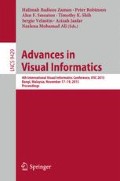Abstract
Innovation is the main way that leads the industries to attain high profit. There several methods and tools to assist designers systematically towards the generation of new ideas and problem solving and TRIZ is one of the methods. However, this assistance is not enough to generate a successful and impeccable product, because an ultimate actor, the end user of the product during development is still underestimated. To satisfy the user’s requirements, designers or developers must keep into consideration also the usability methods. Unfortunately, these methods are not as organized as the TRIZ theory and often it is very challenging to apply them in an effective way. Therefore, it seems quite realistic to think through the development of innovative, as helped by a synergy between the Usability and the TRIZ theories. After some highlights about similarities and differences of these two methods, this paper develops the basis of a new integrated analytical method that able to suggest a collection of guidelines for the definition and implementation of engineering requirements.
Access this chapter
Tax calculation will be finalised at checkout
Purchases are for personal use only
References
Domb, E., Rantanen, K., Simplified, T.: New Problem-Solving Applications for Engineers & Manufacturing Professionals. St. Lucie Press, CRC Press, Boca Raton, FL (2002)
Ettlie, J.: Managing innovation. Routledge (2007)
Fresner, J., Jantschgi, J., Birkel, S., Bärnthaler, J., Krenn, C.: The theory of inventive problem solving (TRIZ) as option generation tool within cleaner production projects. J. Clean. Prod. 18, 128–136 (2010)
Hipple, J.: The use of TRIZ principles in consumer product design. In: Proceedings: Papers presented at the Altshuller Institute for TRIZ Studies Symposiums (TRIZ CONs) on TRIZ Methodology and Application, June 2006
Hix, D., Hartson, H.R.: Developing user Interfaces: Ensuring Usability Through Product & Process. John Wiley & Sons Inc., New York (1993)
Nielsen, J.: Usability Engineering. Morgan Kaufmann Publishers Inc., San Francisco (1993)
John, B.E.: Evaluating usability evaluation techniques. ACM Comput. Surv. (CSUR) 28, 139 (1996)
Kaplan, S.: An introduction to TRIZ: The Russian Theory of Inventive Problem Solving. Ideation International, Southfield (1996)
Maguire, M.: Context of use within usability activities. Int. J. Hum Comput Stud. 55, 453–483 (2001)
Mann, D.: Unleashing the Voice of the Product and the Voice of the Process. TRIZCON, Milwaukee (2006)
Nielsen, J.: Usability Engineering. Morgan Kaufmann Publishers Inc., San Francisco (1993)
K. Rantanen.: Brain, Computer and the Ideal Final Result, TRIZ Journal, November (1997). http://www.triz-journal.com/archives/1997/11/a/
Shneiderman, B.: Creating creativity: user interfaces for supporting innovation. ACM Trans. Comput.-Hum. Interact. (TOCHI) 7, 114–138 (2000)
Tate, K., Domb, E.: 40 Inventive Principles with Examples. The TRIZ J. (1997). http://wwwtriz-journal.com/archives/1997/07/b/index.html
Yamashina, H., Ito, T., Kawada, H.: Innovative product development process by integrating QFD and TRIZ. Int. J. Prod. Res. 40, 1031–1050 (2002)
Zlotin, B., Zusman, A., Kaplan, L., Visnepolschi, S., Proseanic, V., Malkin, S.: TRIZ beyond technology: The theory and practice of applying TRIZ to nontechnical areas. Detroit: Ideation. Retrieved June 2, 2005 (1999)
Zusman, A.: Problems in the development and marketing of TRIZ. In: TRIZ in Progress: Transactions of the Ideation Research Group (1999)
Author information
Authors and Affiliations
Corresponding author
Editor information
Editors and Affiliations
Rights and permissions
Copyright information
© 2015 Springer International Publishing Switzerland
About this paper
Cite this paper
Batemanazan, V., Jaafar, A., Nayan, N.M., Kadir, R.A. (2015). Synergy Between TRIZ and Usability: A Review. In: Badioze Zaman, H., et al. Advances in Visual Informatics. IVIC 2015. Lecture Notes in Computer Science(), vol 9429. Springer, Cham. https://doi.org/10.1007/978-3-319-25939-0_45
Download citation
DOI: https://doi.org/10.1007/978-3-319-25939-0_45
Published:
Publisher Name: Springer, Cham
Print ISBN: 978-3-319-25938-3
Online ISBN: 978-3-319-25939-0
eBook Packages: Computer ScienceComputer Science (R0)

